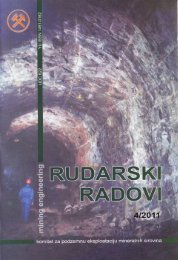Institut za rudarstvo i metalurgiju Bor
Institut za rudarstvo i metalurgiju Bor
Institut za rudarstvo i metalurgiju Bor
Create successful ePaper yourself
Turn your PDF publications into a flip-book with our unique Google optimized e-Paper software.
GEO-MECHANICAL FEATURES OF<br />
THE TERRAIN<br />
The site prospecting up to 12.0 m<br />
depth separates the layers of dikes, loamy<br />
clays, dusty sandy clays and sandy clays<br />
and clayey muddy dusts, Figure 2. The<br />
last two layers can be divided into a dust<br />
layer of clay sediments from lower layers<br />
of silt materials. Below the layer above<br />
the sandy gravel sediments , this prospecting<br />
is not registered.<br />
The results of site prospecting and laboratory<br />
tests have given the information necessary<br />
for further geomechanical calculations.<br />
Data obtained in the laboratory are somewhat<br />
better in relation to the terrain characteristics<br />
defined during drilling and core from the<br />
recording drillholes. This primarily refers to<br />
the layer of clayey dusty sediments with interlayers<br />
of muddy material.<br />
In order to build these facilities, the<br />
certain stability analysis for the coast natural<br />
conditions and conditions that will occur<br />
provided the construction of buildings was<br />
implemented. For clayey dusty sediments,<br />
the adopted parameters are somewhat lower<br />
due to the presence of muddy components:<br />
γ pot. = 9.6 kN/m 2 , φ = 10 0 and c = 8 kN/m 2 ,<br />
where the following values were obtained:<br />
• the natural state with no load, the water<br />
level of 83.0 m, Fs = 1.226<br />
• the natural state of the specified load,<br />
water level 83.0 m, Fs = 1.112<br />
Given the above analysis to date features<br />
of the terrain, dust sediments are<br />
favorable for the foundation support struc<br />
tures which are planned to ensure the road<br />
trunk. For improvement the security of<br />
support structures, it is necessary to replace<br />
materials with good quality gravel<br />
from the river Sava, which in the good<br />
conditions of compactness could be a stable<br />
support. The replacement of material<br />
will prevent the export of finest particles,<br />
which would result into the terrain stabili<strong>za</strong>tion<br />
of embankment.<br />
CONCLUSION<br />
The investigations, conducted for the<br />
purpose of planning the right riverside of<br />
the river Sava in Brcko, gave the necessary<br />
information about the geological<br />
structure and geomechanical characteristics<br />
of the terrain. The laboratory testing<br />
results are partly differ from the site data<br />
obtained during the investigation and<br />
mapping the drillholes. The differences<br />
are related to the presence of sludge materials<br />
in clayey dusty layer that deteriorates<br />
its properties.<br />
The analysis of stability for the riverside<br />
natural conditions and conditions that<br />
will occur in construction of buildings,<br />
shows that the terrain is located somewhere<br />
on the border between the natural<br />
balance, so that each new intervention on<br />
the ground require more detailed analysis<br />
and calculations of terrain stability as well<br />
as load of individual layers for foundations<br />
of facilities.<br />
No 1, 2010. 23<br />
MINING ENGINEERING



